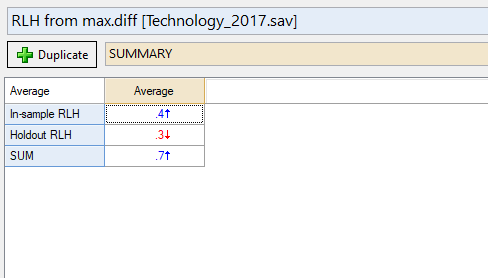Marketing - MaxDiff - Save Variable(s) - RLH (Root Likelihood)
Creates variables which contain RLH (root-likelihood) for each respondent, according to a MaxDiff latent class analysis or MaxDiff hierarchical Bayes output. You should select the output before running this script. If the model output contained holdout questions, variables for in-sample and holdout RLH will be created, otherwise, just one RLH variable will be created. Model outputs will first need to be recalculated if they were created prior to November 2018.
Example
The script produces a SUMMARY table of the new RLH variable(s):
Technical details
The RLH for each respondent is the geometric mean of the likelihoods of their tasks, i.e., the kth root of the product of the likelihoods, where k is the number of tasks for the respondent.
How to apply this QScript
- Start typing the name of the QScript into the Search features and data box in the top right of the Q window.
- Click on the QScript when it appears in the QScripts and Rules section of the search results.
OR
- Select Automate > Browse Online Library.
- Select this QScript from the list.
Customizing the QScript
This QScript is written in JavaScript and can be customized by copying and modifying the JavaScript.
Customizing QScripts in Q4.11 and more recent versions
- Start typing the name of the QScript into the Search features and data box in the top right of the Q window.
- Hover your mouse over the QScript when it appears in the QScripts and Rules section of the search results.
- Press Edit a Copy (bottom-left corner of the preview).
- Modify the JavaScript (see QScripts for more detail on this).
- Either:
- Run the QScript, by pressing the blue triangle button.
- Save the QScript and run it at a later time, using Automate > Run QScript (Macro) from File.
Customizing QScripts in older versions
JavaScript
includeWeb('QScript R Output Functions');
let r_code = `
if (is.null(input.maxdiff$rlh.out) && is.null(input.maxdiff$rlh)) {
stop("RLH is not available for the MaxDiff Rank-Ordered Logit with Ties model")
}
if (is.null(input.maxdiff$rlh.out)) {
input.maxdiff$rlh
} else {
result <- cbind(input.maxdiff$rlh, input.maxdiff$rlh.out)
colnames(result) <- c("In-sample RLH", "Holdout RLH")
result
}
`;
saveVariables('RLH', 'MaxDiff',
'input.maxdiff = ',
r_code, null, null, 'rlh', 'FitMaxDiff');
See also
- QScript for more general information about QScripts.
- QScript Examples Library for other examples.
- Online JavaScript Libraries for the libraries of functions that can be used when writing QScripts.
- QScript Reference for information about how QScript can manipulate the different elements of a project.
- JavaScript for information about the JavaScript programming language.
- Table JavaScript and Plot JavaScript for tools for using JavaScript to modify the appearance of tables and charts.
See MaxDiff Software or What is MaxDiff? for an overview of key MaxDiff concepts and resources.
Extensions
Q Technical Reference
Q Technical Reference
Q Technical Reference > Setting Up Data > Creating New Variables
Q Technical Reference > Updating and Automation > Automation Online Library
Q Technical Reference > Updating and Automation > JavaScript > QScript > QScript Examples Library > QScript Online Library
R Online Library
User Interface > Create Marketing
